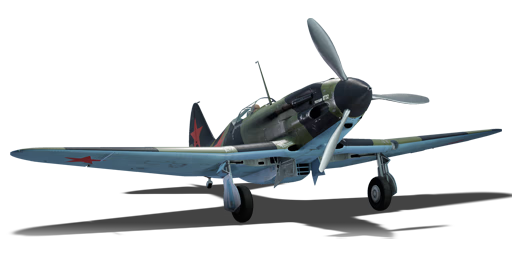



The MiG-3-34 was an experimental variant of the MiG-3 series, that tried to address the relatively weak firepower that previous models had. The MiG-3-34 was meant to be a high-altitude fighter, and was one of the few Soviet fighters capable of doing so, but still not at the level of American or German fighters like the P-51 and Bf 109. The MiG-3 suffered from a lot of problems in its development, from negligent quality control in the assembly line to deficient armament and poor oxygen supply. The MiG-3 was caught in a tough spot during Operation Barbarossa: instead of intercepting bombers, it clashed against much more agile Bf 109s. The aircraft was deemed much inferior and quickly phased out in favour of more capable low altitude Yak and LaGG fighters.
Introduced in Update 1.41, the MiG-3-34 is a fairly competitive aircraft for its BR. It should be played similarly to aircraft like the I-185 and I-225, using its good top speed and acceleration. Since it lacks the agility and armament to go toe-to-toe against aircraft like the Spitfire and Bf 109, the MiG-3-34 should climb to high altitudes, especially to intercept enemy bombers. At altitudes above 4,000 m, the MiG-3-34's engine starts to perform at its maximum capacity, and its lack of agility is compensated at higher altitudes when speed and acceleration starts to become more important.
flaps
flaps
flaps
brake
| Belt | Belt filling | Armor penetration (mm) at a distance: | |||||
|---|---|---|---|---|---|---|---|
| 10 m | 100 m | 500 m | 1000 m | 1500 m | 2000 m | ||
| FI-T/AP-I | 28 | 24 | 14 | 7 | 4 | 2 | |
| FI-T/HEF/AP-I/FI-T | 28 | 24 | 14 | 7 | 4 | 2 | |
| HEF/FI-T/AP-I | 28 | 24 | 14 | 7 | 4 | 2 | |
| FI-T | 3 | 3 | 3 | 3 | 3 | 3 | |
| AP-I/FI-T/AP-I/AP-I | 28 | 24 | 14 | 7 | 4 | 2 | |
| AP-I/HEF/HEF/FI | 28 | 24 | 14 | 7 | 4 | 2 | |












Flight performance | |
|---|---|
Survivability |
|---|
Weaponry |
|---|